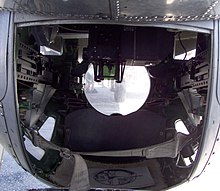A ball turret was a spherical-shaped, altazimuth mount gun turret, fitted to some American-built aircraft during World War II. The name arose from the turret's spherical housing.
It was a manned turret, as distinct from remote-controlled turrets also in use. The turret held the gunner, two heavy machine guns, ammunition, and sights. The Sperry Corporation designed, ventral versions became the most common version, thus the term "ball turret" is most specific to these versions.
Contents
Sperry ball turret
Interior of the Sperry ball turret of a preserved B-17 (2008)
The Sperry ball turret was very small in order to reduce drag, and was typically operated by the shortest man of the crew. To enter the turret, the turret was moved until the guns were pointed straight down. The gunner placed his feet in the heel rests and then crouched down into a fetal position. He would then put on a safety strap, close and lock the turret door. There was no room inside for a parachute, which was left in the cabin above the turret. A few gunners wore a chest parachute.
The gunner crouched in a fetal position within the turret with his back and head against the rear wall, his hips at the bottom, and his legs held in mid-air by two footrests on the front wall. This left him positioned with his eyes roughly level with the pair of light-barrel Browning AN/M2 .50 caliber machine guns which extended through the entire turret, and located to either side of the gunner. The cocking handles were located too close to the gunner to be operated easily, so a cable was attached to the handle through pulleys to a handle near the front of the turret. Another important factor relative to the guns was the fact that not all stoppages could be corrected by simply charging (cocking) the guns. In many cases, when a gun failed to fire, it was necessary for the gunner to "reload" the gun, which required access to the firing chamber of the guns. Access to the firing chamber of the guns was severely restricted by the guns location in the small turret. Normally, the gunner accessed the firing chamber by releasing a latch and raising the cover to a position perpendicular to the gun but this was not possible in the ball turret. To remedy that, the front end of the cover was "slotted". The gunner released the latch and removed the cover which allowed a few inches over the firing chamber for the gunner to access and clear a stoppage. Small ammunition boxes rested on the top of the turret and the remaining ammunition belts fed the turret by means of an elaborate chute system. A reflector sight was hung from the top of the turret, positioned roughly between the gunner's feet.
The directional control was by two hand control grips with firing buttons incorporated. The left foot controlled the reflector sight range reticule. The right foot operated a push-to-talk intercom switch. The turret was normally electrically powered in azimuth and altitude. An emergency hand crank could be attached to reposition the turret from inside the aircraft fuselage. In the event of a power failure another crewman would use this to crank the turret into the vertical position to allow the gunner to exit.[1]
A B-24J's Sperry ventral ball turret in its retracted position for landing, as seen from inside the bomber.
In the case of the B-24, the Liberator's tricycle landing gear design mandated that its A-13 model Sperry ball turret have a fully retractable mount, so that the ball turret would always be retracted upwards into the lower fuselage while the aircraft was on the ground, providing ground clearance with it in the stowed position.
ERCO ball turret
An Erco ball turret
Erco Ball turret, on display at National Museum of Naval Aviation, FL.




No comments:
Post a Comment